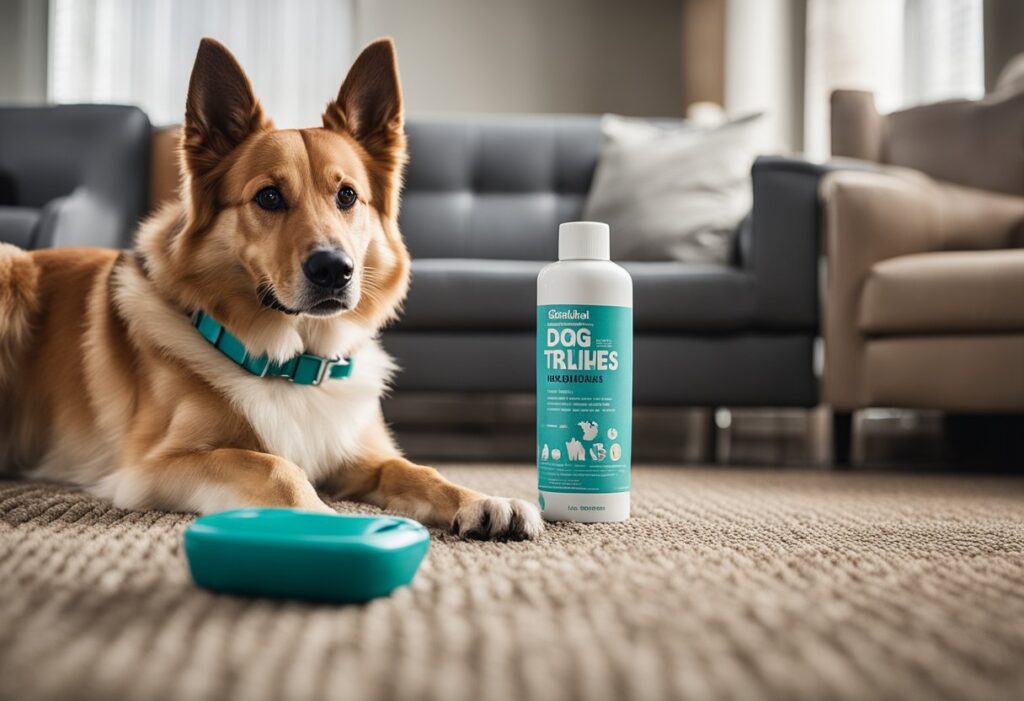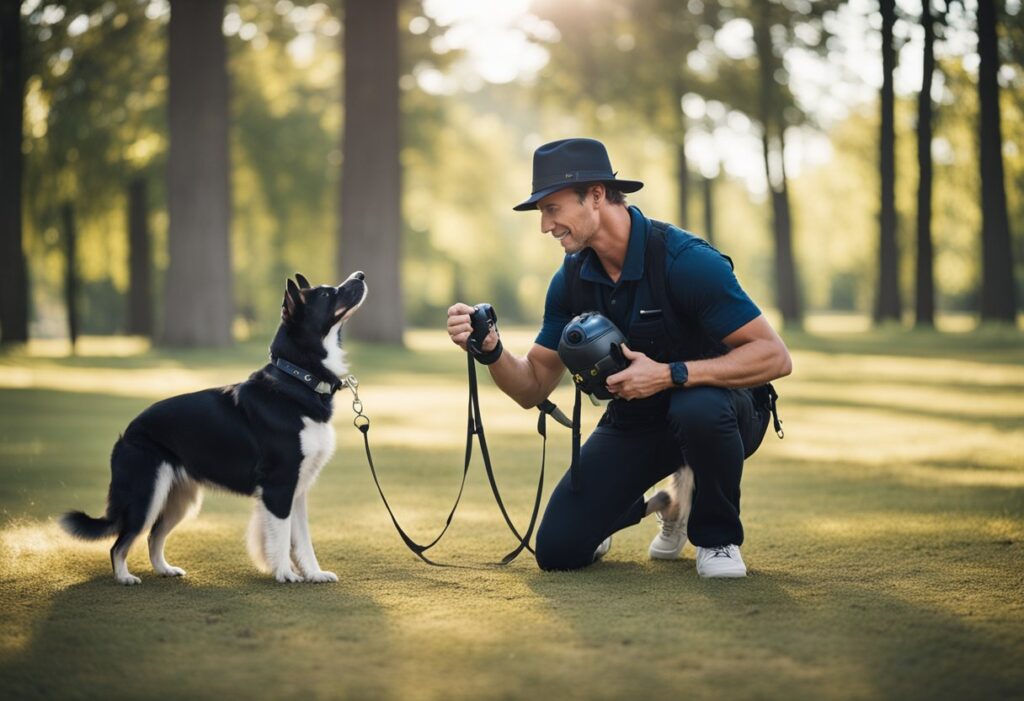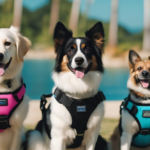Dog training can be a challenging task, especially for first-time dog owners. It requires patience, consistency, and the right tools to achieve the desired results. Fortunately, there are many dog training aids available in the market that can help you train your dog effectively and efficiently. In this article, we will explore some of the essential dog training aids and how they can be used to train your furry friend.

Understanding dog training aids is crucial to ensure that you choose the right tools for your dog’s training. Dog training aids can be broadly categorized into two types: positive reinforcement tools and aversive tools. Positive reinforcement tools, such as clickers, treats, and toys, are used to reward good behavior and encourage your dog to repeat it. Aversive tools, such as shock collars and choke chains, are used to punish bad behavior and discourage your dog from repeating it. It is important to note that aversive tools should only be used as a last resort and under the guidance of a professional dog trainer.
Essential training products, such as collars, leashes, and crates, are also important dog training aids. Collars and leashes help you control your dog’s movement and behavior, while crates provide a safe and comfortable space for your dog to rest and relax. Additionally, training environments and aids, such as treat pouches and training mats, can help create a positive and conducive environment for your dog’s training. By using the right dog training aids, you can make the training process more enjoyable and effective for both you and your furry friend.
Key Takeaways
- Understanding dog training aids is crucial for effective dog training.
- Positive reinforcement tools are preferable to aversive tools.
- Essential training products and training environments and aids are also important for effective dog training.
Dog Training Aids
| Product Name | Rating | Price |
|---|---|---|
| BARKIE Dog Treat Pouch & Clickers | 4.9 | $9.99 |
| Dog Bark Deterrent, Rechargeable | 4.8 | $25.99 |
| PupSensei Treat Pouch, Magnetic Closure | 4.8 | $17.99 |
| BALYWOOD Anti Barking Device | 4.6 | $27.99 |
| Caldwell’s Dog Potty Bell | 4.6 | $8.99 |
| NPS Bark Deterrent with Sonic Emitters | 4.6 | $39.99 |
| CATHYLIFE Leather Dog Doorbells | 4.5 | $15.97 |
| Diggs Groov Dog Training Toy | 4.5 | $34.00 |
| Hi Kiss Dog Obedience Training Lead | 4.5 | $8.97 |
| 2023release Dog Bark Deterrent Device | 4.5 | $37.99 |
| BARKIE Dog Training Kit | 4.5 | $22.23 |
| Interactive Flirt Pole Toy | 4.4 | $28.99 |
| FINEST+ Voice Recording Button | 4.4 | $15.99 |
| HoAoOo Pet Training Clicker | 4.3 | $3.99 |
| PATPET Dog Training Collar | 4.3 | $29.99 |
| PET CORRECTOR Dog Trainer, 200ml | 4.2 | $16.90 |
| Dog Shock Collar with Remote | 4.2 | $35.99 |
| The Company of Animals Dog Trainer | 4.1 | $10.31 |
| Hemp Calming Chews for Dogs | 4.0 | $22.99 |
| cambk Dog Treat Pouch Training Kit | 3.8 | $8.49 |
| ABHY Wireless Dog Fence | 3.8 | $169.99 |
| Rocco & Roxie Puppy Potty Training Spray | 3.4 | $12.97 |
| OUT! PetCare Go Here Attractant Spray | 3.1 | $7.48 |
*Please note that prices are subject to change and may vary depending on the seller, location, and any applicable discounts or promotions. The ratings provided are based on customer reviews and may also change over time. Amazon Affiliate Link.
Understanding Dog Training Aids
As dog owners, we all want to ensure that our furry companions are well-behaved and obedient. One of the most effective ways to achieve this is through training. However, training a dog can be a challenging task, especially for first-time dog owners. This is where dog training aids come in handy.
Types of Training Aids
There are several types of dog training aids available in the market today. These aids are designed to help make the training process easier and more effective. Some of the most common types of training aids include:
- Collars and Leashes: Collars and leashes are essential training aids that help you control your dog’s movements. A collar is used to hold your dog’s ID tag, while a leash is used to keep your dog close to you during training.
- Clickers: Clickers are small handheld devices that make a clicking sound when pressed. They are used to mark a desired behavior and to communicate with your dog during training.
- Treats: Treats are a popular training aid that can be used to reward your dog for good behavior. They are especially useful for positive reinforcement training.
- Training Pads: Training pads are absorbent pads that are used to house train puppies. They are designed to absorb urine and prevent messes on your floors.
Choosing the Right Aids
Choosing the right dog training aids can be overwhelming, especially with so many options available. When selecting training aids, it is important to consider your dog’s breed, age, and temperament. Some dogs may respond better to certain types of training aids than others.
It is also essential to choose high-quality training aids that are safe and effective. Look for products that are made from durable materials and are designed to withstand frequent use. Additionally, read product reviews and ask for recommendations from other dog owners to ensure that you are selecting the right aids for your furry friend.
In conclusion, dog training aids can be incredibly helpful in training your furry companion. By understanding the different types of training aids available and choosing the right ones for your dog, you can make the training process easier and more effective.
Essential Training Products

When it comes to training your dog, having the right tools can make all the difference. We’ve compiled a list of essential training products that every dog owner should consider.
Collars and Harnesses
Collars and harnesses are essential for controlling your dog and keeping them safe. A collar is a simple and effective way to attach identification tags and a leash. A harness is a great alternative to a collar, especially for dogs with respiratory issues or neck injuries. Harnesses distribute the pressure evenly across the dog’s chest, making it a safer option for controlling your dog.
There are several types of collars and harnesses available, including training collars, retractable leashes, and halters. It’s important to choose a collar or harness that fits your dog properly and is comfortable for them to wear.
Leashes and Long Lines
Leashes and long lines are essential for controlling your dog and keeping them safe. A leash is a simple and effective way to keep your dog close to you and prevent them from running off. A long line is a great alternative to a leash, especially for training purposes. A long line allows your dog to explore while still being under your control.
There are several types of leashes and long lines available, including retractable leashes and long lines made from nylon or leather. It’s important to choose a leash or long line that is appropriate for your dog’s size and strength.
Clickers and Treat Pouches
Clickers and treat pouches are essential for positive reinforcement training. A clicker is a small device that makes a clicking sound when pressed. It’s used to mark the desired behavior and signal to your dog that a treat is coming. A treat pouch is a small bag that can be attached to your waist or pocket. It’s used to hold treats and keep them easily accessible during training sessions.
Using a clicker and treat pouch together can be a powerful training tool. It allows you to quickly and easily reward your dog for good behavior, which can help reinforce the desired behavior.
Overall, these essential training products can make a big difference in your dog’s training journey. By choosing the right collar or harness, leash or long line, and using a clicker and treat pouch, you can set your dog up for success and make training a positive and enjoyable experience for both of you.
Positive Reinforcement Tools
Positive reinforcement is an effective way to train dogs and encourage good behavior. Here are some of the most useful positive reinforcement tools:
Training Treats
Training treats are small, bite-sized treats that are used to reward dogs for good behavior during training. They are usually soft and easy to chew, so that dogs can quickly eat them and get back to training.
When choosing training treats, it’s important to look for treats that are healthy and nutritious. Treats that are high in protein and low in fat are a good choice, as they provide dogs with the energy they need to stay focused during training.
Some popular training treats include Zuke’s Mini Naturals, Blue Buffalo Bits, and Wellness Soft Puppy Bites.
Treat Bags and Pouches
Treat bags and pouches are used to store training treats during training sessions. They are usually worn around the waist or attached to a belt, so that trainers can easily access treats when needed.
When choosing a treat bag or pouch, it’s important to look for one that is durable and easy to clean. A bag with multiple pockets can be useful, as it allows trainers to store other training tools, such as clickers and whistles.
Some popular treat bags and pouches include the PetSafe Treat Pouch, Outward Hound Treat Bag, and Paw Lifestyles Treat Training Pouch.
Using training treats and treat bags can be a great way to reinforce positive behavior in dogs. By rewarding good behavior with treats, trainers can encourage dogs to repeat that behavior in the future.
Training Environments and Aids

When it comes to dog training, the environment and tools you use can make a big difference in your pup’s success. Here are some training aids that can help create a positive learning environment for your furry friend.
Crates and Training Mats
Crates are an essential tool for puppy training, as they provide a safe and comfortable space for your pup to rest and relax. They can also be used for crate training, which is a method of housebreaking that involves teaching your dog to go to the bathroom outside of their crate. Training mats can also be used to create a designated area for your pup to rest or play. They can be especially helpful for puppies who are still learning to control their bladder.
Toys and Chew Toys
Toys and chew toys are great tools for training and enrichment. They can be used to redirect your pup’s attention away from unwanted behaviors, such as chewing on furniture or shoes. Toys can also be used to teach your dog new commands, such as “fetch” or “drop it.” Chew toys can help satisfy your pup’s natural urge to chew, which can help prevent destructive chewing behavior. When selecting toys and chew toys, make sure to choose ones that are appropriate for your dog’s size and chewing habits.
Overall, creating a positive training environment is key to your dog’s success. By using tools such as crates, training mats, toys, and chew toys, you can help create a safe and comfortable space for your pup to learn and grow.
Advanced Training Techniques

When it comes to advanced dog training, there are several techniques that pet owners can use to teach their dogs new skills and behaviors. In this section, we will discuss two of the most important techniques that can be used to train your dog: house training and barking control.
House Training
House training, also known as potty training, is one of the most important skills that all dogs must learn. It involves teaching your dog to relieve themselves outside or in a designated area indoors. This can be achieved through the use of positive reinforcement, consistency, and patience.
To house train your dog, you will need to establish a routine and take your dog outside at regular intervals throughout the day. You should also reward your dog with treats and praise when they relieve themselves in the designated area. It is important to avoid punishing your dog for accidents, as this can lead to anxiety and other behavioral issues.
In addition to positive reinforcement, there are several dog training tools and aids that can be used to aid in house training. These include potty pads, crates, and indoor grass patches. These products can help to reinforce good behavior and make the training process easier for both you and your dog.
Barking Control
Barking is a natural behavior for dogs, but excessive barking can be a nuisance for pet owners and their neighbors. To control barking, it is important to understand why your dog is barking in the first place. Common reasons for barking include boredom, anxiety, and territorial behavior.
To control barking, you can use a variety of dog training products and aids, such as anti-bark collars, training collars, and ultrasonic devices. These products can help to discourage excessive barking and reinforce good behavior. It is important to choose a product that is appropriate for your dog’s size, breed, and temperament.
In addition to using training aids, it is important to address the underlying cause of your dog’s barking. This may involve providing more exercise and mental stimulation, or addressing any underlying anxiety or behavioral issues. With patience and consistency, you can help your dog learn to control their barking and become a well-behaved member of your family.





